How to organize water supply to the house: choosing a water supply method + arrangement options
Uninterrupted and high-quality water supply to the cottage is a prerequisite for comfortable living there. There are several ways to arrange water supply to the house. There are three main schemes, in each case the optimal option will be different. To choose the right scheme, you need to know everything. Do you agree?
We will talk about how you can connect the water supply system to your home. The article we presented describes in detail the options for designing sources. The specifics of introducing systems into the facility being developed are analyzed.
The content of the article:
Methods of supplying water to the house
It is possible to provide the cottage and site with drinking water using a centralized or autonomous water supply. These are two fundamentally different ways of obtaining life-giving moisture.
In the first case, a connection is made to the existing water supply in the village, and in the second, water intake is organized individually in the area adjacent to the residential building. And each of these options has its own advantages.
You can simply bring drinking water to the cottage in cans or from time to time order a water truck to fill the container installed on the site. However, this method is only acceptable for non-permanent residence and/or for one person. But if a family with a child lives in the house, then the water supply should be more thoroughly arranged.
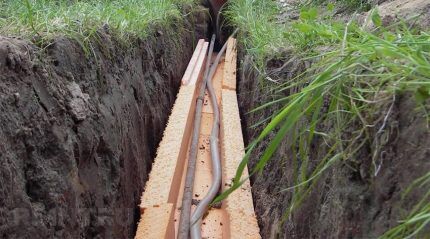
Autonomous water intake is organized on the basis of:
- well;
- wells (pressure or free-flow);
- spring or other natural body of water.
Most often, wells and free-flow wells are chosen among these options. They are equipped with pumps to pump out water, which is then supplied to the house. Arranging them takes a minimum of time and costs reasonable money.
At the same time, the well is also good because in the event of a power failure, drinking liquid can be obtained from it with a simple bucket.
Organization cottage water supply as follows:
- The water source is selected - a mainline or a well/well.
- A water intake is created - a connection is made to the village water supply or a well is drilled/well dug.
- A pipe is laid from the source to the house.
- The installation of a water pipeline into the cottage is being organized.
- In-house wiring of cold water and hot water pipes is carried out with the connection of all the necessary equipment for cleaning, heating and water metering.
- The plumbing is being connected.
Also, usually from the house, water supply is installed around the area for watering the garden and supplying utility rooms with water. Do not forget that the organization of water supply can only be carried out if drainage systems from a water-supplied cottage.
Centralized or autonomous water supply?
If there is a village water supply network, then most private homeowners prefer to connect to it. This often works out cheaper and easier.However, autonomous water supply also has its advantages.
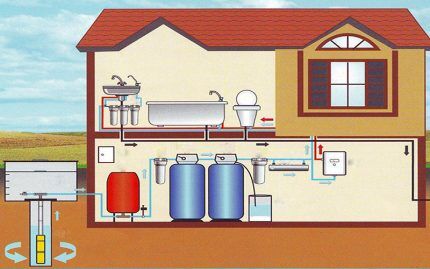
When choosing a source of water supply, you should compare all the pros and cons of the options. Then redoing the entrance to the house will be problematic. Moreover, in most cases it will be necessary not only to relay this street section of the water supply system, but also to partially change the equipment and rebuild the in-house wiring.
Permission to connect to a water intake
From the point of view of bureaucratic delays and preparation of permits autonomous water supply greatly outperforms the centralized alternative. Any owner of a private house can dig a well or drill a regular well on a property.
You do not need to obtain permits to organize such water intake on your own territory. In some municipal settlements, the preparation of documents for connection to the highway is undertaken by local authorities or the developer of the cottage village.
But usually this happens exclusively during complex development in a new location. In other cases, you will have to run a lot to get the necessary papers and pay a tidy sum.
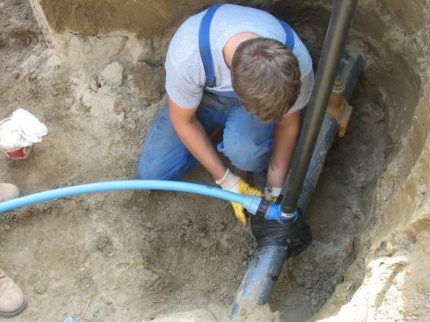
To connect a private household to a centralized water supply network, you will need to obtain the following documents:
- Submitting an application for connection to the supplying organization.
- Obtaining technical conditions (specifications for connection).
- Preparation and approval of the insertion project.
- Connection to the main line and insertion of the outlet pipe into the house.
- Conclusion of a water supply contract.
And if it is still possible to fill out a sample application for the required volume of water and sign contracts on your own, then all other stages will have to be completed with the involvement of outside specialists. In terms of money, this often amounts to tens of thousands of rubles, or even more.
And to make an autonomous water intake in the form of a well or shallow borehole, it is enough to agree with an installation company that provides such services. There is no need to obtain prior permission here.
In terms of cost, this option is even cheaper than the centralized one. However, much depends on the depth of the aquifer and its presence on the site. If you need to drill a deep artesian well, it will obviously be more expensive than connecting to the main line.
Installation of counters and filters
A metering device is only necessary when water is supplied to the house from the public water supply network. In this case, you will have to submit monthly water meter readings to utilities and pay for the resource.
If a well is installed or a well is dug, then no one will need to report on the volume of water taken from the ground with their help. It is not forbidden to install a meter in such a water supply system. However, it will only be needed for your own accounting.
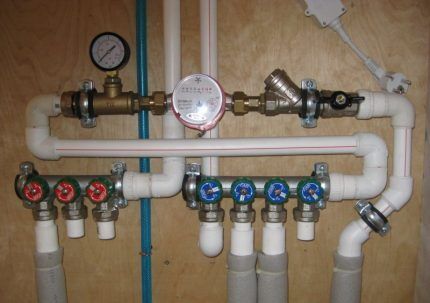
The situation with water treatment is radically different. The resource supplying organization is responsible for the quality of water from the network.Now such companies are subject to quite serious control regarding compliance with SanPiNov. And if necessary, you can always find a council for public utilities.
If water is taken from an autonomous water intake, then the owner of the site and house is solely responsible for its quality and compliance with standards. All questions regarding water purification from impurities and microflora dangerous to humans fall on the owner of the cottage.
Conventional coarse filters are inexpensive. But if the water from the ground is hard and/or with a large volume of various impurities, then its purification can cost a lot of money. Equipment for such cases is expensive in terms of both purchase, installation, and subsequent operation. And without it, the water will be undrinkable.
If there are sources of aquifer contamination near the house, then it is better to refuse an autonomous water supply. In such a situation, ensuring proper water quality yourself will be difficult and expensive.
Terms of connection to the water intake
In terms of the time spent organizing water supply, the autonomous option wins. Direct work on water supply device in both cases they take place in approximately the same time frame. However, coordinating a connection to the village network and obtaining technical specifications takes from a couple of weeks to 3–4 months.
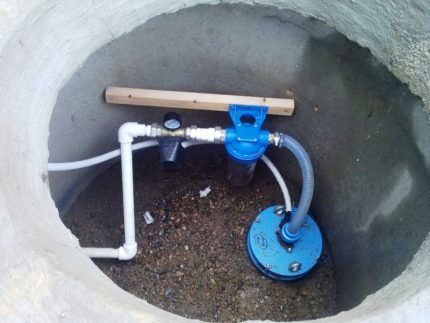
If there are no problems finding the aquifer, then dig a well or drill a water well It will be quite possible in one working day. The process of tapping into a water main is actually just as quick.But it often takes several months to coordinate the project in the second version and receive technical conditions.
Which is better to choose: a well or a well? This issue is discussed in detail in next article, the contents of which we recommend that you familiarize yourself with.
Methods for supplying water to a cottage
The arrangement of water supply in a private house is carried out in three stages:
- Organization of water intake.
- Laying a pipe on the street and introducing it into the cottage through the foundation.
- Distribution of water pipes in a residential building.
The first point is described above, and the third is a separate topic that deserves its own large article.
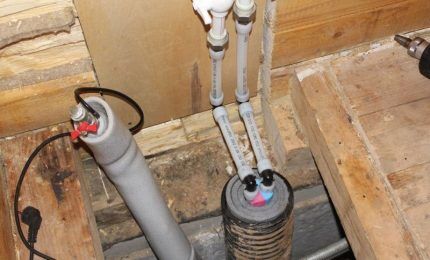
The water supply to the cottage is usually carried out by a pipe with a diameter of 25–32 mm. It requires digging a trench with a depth below the freezing point of the soil. Moreover, this hole often has to be deepened by 1.5–2 meters so that the pipeline in it does not freeze in winter.
If the outer part of the system is laid above the seasonal freezing horizon, it is necessary to take measures to prevent the formation of ice plugs in the main line. Methods for heating water pipes are given in the article we recommended.
If water is taken from a well or well, then the street pipe should be laid with a slight slope towards the water intake. So, after turning off the pump, excess liquid will flow by gravity back to the source, without stagnating in the water supply.
To pass through the foundation, a hole is drilled in it 10–20 mm wider than the pipeline being laid.Then a small piece of pipe of the appropriate cross-section is inserted into this hole as a case with filler in the form of polyurethane foam. It is needed to protect the input pipe from ground movements during soil heaving in winter.
Method #1 - from the village highway
This option is the easiest to implement. But then you will have to pay the meter every month. The organization of such input will have to be entrusted to installers from the water utility or specialists from a third-party company that has the appropriate permits to work.
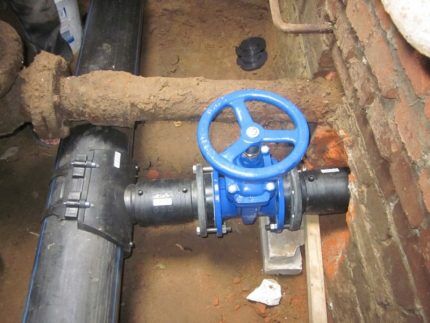
Two main disadvantages of centralized water supply:
- Lack of water during breaks and other accidents in the common water main.
- Considerable time costs for connection approval.
However, in the vast majority of cases, the water supplied to the house is of higher quality than that from the well. The water utility is responsible for its quality.
Method #2 - from a source on the site
The main advantage of a well and a well is its autonomy. Any accidents on the village water supply system do not affect the owner of the autonomous water supply system. There is always water in the house. You only need to worry about the stability of the power supply to the pumps in advance by purchasing a UPS (uninterruptible power supply) or a generator.
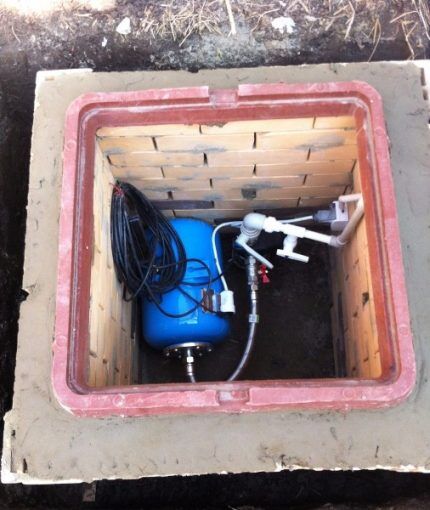
Before introducing water into a private house in this way, it is necessary to find out the level of its return from the aquifer existing on the site.
If the water intake is not able to provide the required volume, the well will begin to silt and fail. Therefore, it is necessary to carefully calculate the water supply project for the cottage in advance, taking into account all the plumbing, so as not to make a mistake later.
The most common and relatively reliable option for organizing such a water intake is water well with a submersible pump, drilled next to the house.
It can be done anywhere in the area where there is water. The pumping equipment in this scheme is located directly in the non-freezing well, and the filters and membrane tank are in the basement of the cottage.
Connection is made in the following order:
- Submersible pump.
- Check valve.
- HDPE pipe up the well and further sideways along the trench to the house.
- Ball valve (already in the basement).
- Coarse filter.
- Pressure gauge and pressure switch with pump control unit.
- Tee with outlet to hydraulic accumulator.
- Ball valve.
Next comes the drainage for supplying water to the street for watering the garden and the distribution of cold water pipes throughout the building. During installation, free access to shut-off valves and sensors should be ensured. The need to shut off the water and check the values on the pressure gauge may arise at any time.
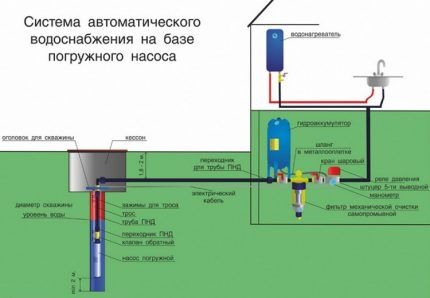
After hydraulic accumulator You can install another finer filter.But the first one, self-flushing, should be in place at the beginning in any case, so that the membrane in the expansion tank is not damaged by solid impurities in the water from the well.
The submersible pump can also be replaced with a ready-made pumping station with hydraulic accumulator and surface hydraulic pump. However, this option will be noisier.
Method #3 - from a well in the house
In order not to tempt fate with the possible freezing of a pipe on the street and not to dig a trench under it, you can drill a well directly in the cottage. This water intake is made in the basement or utility room of the house. In this case, the filters and pump are installed there, if not in a heated, then obviously insulated room.
If your region of residence is -30 °Since winter is the norm outside, this water intake option would be an ideal choice. The risk of pump failure due to freezing of the well is minimal here. However, if there is no water under the house, then the drilling will be in vain.
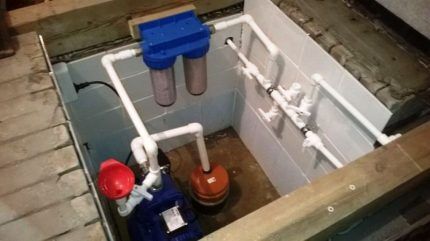
Such a water supply scheme should be chosen only with a clear understanding that there is an aquifer under the cottage, or even before laying the foundation.
Now there is a lot of compact drilling equipment. With a shallow well or Abyssinian well There shouldn't be any problems in the basement. In this case, the connection of filters, automation and pump is carried out according to the scheme described above. Only the HDPE pipe on the street is removed from it.
Conclusions and useful video on the topic
Video #1. Overview of the input node in the basement of a private house:
Video #2. Possible errors when organizing the introduction of cold water into the cottage:
Video #3.Disassembly of the plant into the house of cold water from the well:
It is not difficult to organize the supply of water and its introduction into a private house. If you choose a scheme with a centralized supply from the water utility, then all work will have to be delegated to third-party installers. Here you can only do the pipework inside the cottage.
But it is possible to arrange an autonomous water supply yourself. The main difficulty is the well and well. But even drilling and digging them out is quite possible with your own hands.
Please write comments in the block below. Ask questions about points of interest or unclear points, post photos related to the topic of the article. Share useful information that may be useful to site visitors.




In our case, only a well was acceptable. It was expensive, and even now we have to spend money on maintaining the system. But in many villages, including ours, the water supply is simply terrible. The pipes have not been changed since my grandfather bought the property. The water is all yellow, it must be settled. But most importantly, it is always turned off in the summer. Only at night they occasionally turn it on for two hours. The neighbors are tormented by this, but I don’t know any problems.
We made a well with technical water in our private house. Our water supply is autonomous, we depend only on electricity. What I would like to point out as a plus is that if the water is clean, then it is suitable for internal consumption and can be drunk. There is no need to buy bottled water if you install a system with coarse and fine filtration before serving it to the tap. There is no dependence on centralized water supply. And you don’t have to pay for water, only for electricity. But you need to install and change filters.
There is also connection option 4
and from two water sources at once! In my opinion, it is the most preferable brew (if there is already a well and the main water supply has just been installed)
In this case, of course, we get a rather complex wiring system, especially if we are going to use two sources simultaneously
I would like to see diagrams for solving this wiring)